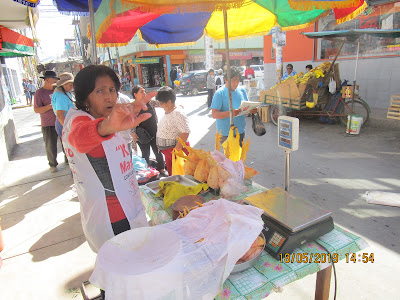This woman, who was selling chickens, was not very pleased to have her photo taken.
We wandered through the town and stopped at the vegetarian cafe for coffee. I ordered a cafe latte and Jim an americano. His americano came with a cup of hot milk beside it. I thought that was the latte but the waitress came back with a tall glass topped with a lot of very sweet cream. I assumed this was the way they did latte here. I removed the cream and discovered that beneath it was ice cream and below that the coffee. It was a coffee glace and was very nice but rather more calorific that I would have liked. Then we went back to the hotel to check out and put our luggage in storage until time for the overnight bus. We sat out at the pool to wait for Charlotte and Sarah They had a wonderful time. The co-pilot in Sarah's plane took her phone and took photos for her so she could concentrate on just looking. Behind her practically everyone was sick so that was unpleasant.
When Sarah and Charlotte came back we headed off for lunch in a mainly vegetarian restaurant. Sarah had tuna and potato and tomato mixed atop a half avocado.
Jim had beef with huancaina sauce. This is one of Henry's favourites - his mother made it frequently for him when he was a child.
Charlotte and I had chicken skewers. The chicken was a bit underdone I thought.
Back at the hotel Charlotte and Sarah relaxed on sunbeds at the pool while I filled in my blog notes.
Then it was off to the Chauchilla cemetery to see ancient burial places and mummies. Our local guide was Hilda. En route she talked to us about how Nazca has changed in her lifetime. The earthquake of 1998 destroyed 80% of the houses. Its epicentre was Nazca. In 2007 the epicentre of the eartquake was Paracas and 519 people dies. Everywhere in Peru there are "s" signs indicating where you should go in the event of seismic activity.
We turned off the main road onto unpaved road which was very very bumpy. Hilda told us that cotton and beans used to be grown in the area but a demand for cochineal meant that people started to grow prickly pear cacti. However the price for cochineal dropped so that practice has stopped.
Evidence that cotton was once a local crop was to be found in several cotton plants to which Hilda drew our attention.
Cotton in a variety of stages of growth.
The Chauchilla cemetery is part of the heritage of the Nazca culture which was based in this region of Peru from 100 BC to 800 AD. Plundered by grave robbers this ancient necropolis has been painstakingly pieced together since 1997 when Peruvian law has protected this Nazca burial ground. Prior to that for many of the ancient corpses it was the second time they lost their heads. Scattered among the many full-bodied mummies at Chauchilla Cemetery are a number of mummified heads. Many of the heads have been specially prepared with holes drilled into the back of their skulls, and, in some cases, rope has been threaded through the mummified heads as if they were to be worn as a necklace or charm. Originally these were thought to be "trophy heads" taken in battle but recent research shows that they actually came from the same population as the rest of the mummies, suggesting that the heads may not have been taken in battle after all.
The human remains are astoundingly well preserved. Burial practices - clothing the corpses in cotton, painting them with resin and placing them in mud-bricked tombs - contributed to the condition of the corpses some still hanging onto their hair and skin over 1200 years after their deaths. The Peruvian desert's dry climate is also a significant factor. The mummies are in an upright position and are facing east as required under the faith of the Nazca people.
The colours on the hills are amazing and your eye is drawn to them in this otherwise empty landscape.
You can still see the eye in the left socket.
These mummies have retained their hair after around 2,00 years!
This was a very sobering experience and I was filled with awe at the fact that these were once living people, living a life that I could not possibly contemplate. Hilda's enthusiasm and knowledge and respect were inspiring. She had us all captivated!
Back along the bumpy unpaved road and on to a ceramic workshop where the artisan makes pottery in the original Nazca way. It was very interesting and I was tempted to buy but resisted. Charlotte bought a musical instrument.
It was back to the hotel and then out for dinner. Then we walked to the bus station where we had half an hour's wait for the overnight bus. Our tickets had us all sitting apart which caused a certain amount of consternation with very few of our group being willing to swap. However, once aboard, Gill came up trumps and everyone got sorted. The bus was very comfortable with a contraption which you pulled forward from the seat in front, lifted your legs into it and, somehow it created a very comfortable position. I slept on and off.
































































No comments:
Post a Comment